automatic transmission BMW 525I SPORT WAGON 2001 Owners Manual
[x] Cancel search | Manufacturer: BMW, Model Year: 2001, Model line: 525I SPORT WAGON, Model: BMW 525I SPORT WAGON 2001Pages: 238, PDF Size: 2.44 MB
Page 10 of 238

Contents
Overview
Controls and features
Cockpit16
Instrument cluster18
Indicator and warning lamps22
Multifunction steering wheel
(MFL) 25
Sports steering wheel26
Hazard warning flashers27
Warning triangle 27
First-aid kit 27
Refueling28
Fuel specifications29
Tire inflation pressure29
Locks and security systems:
Keys36
Electronic vehicle
immobilizer37
Opening and closing –
from the outside38
With the key38
With the remote control39
Opening and closing –
from the inside42
Luggage compartment lid/
Tailgate43
Rear window43
Luggage compartment46
Alarm system47
Electric power windows49
Sliding/Tilt sunroof50
Adjustments:
Seats52
Steering wheel56
Mirrors56
Seat, mirror and steering wheel
memory58
Car Memory, Key Memory60
Passenger safety systems:
Safety belts61
Airbags62
Transporting children safely66
Driving:
Steering/Ignition lock68
Starting the engine68
Switching off the engine69
Parking brake70
Manual transmission70
Automatic transmission72
Automatic transmission with
Steptronic75
Indicator/Headlamp flasher78
Wiper/Washer system78
Rear window defroster80
Cruise control81
Everything under control:
Odometer, outside temperature
display83
Tachometer84
Energy control84
Fuel gauge84
Coolant temperature gauge85
Service Interval Display85
Check Control86
Computer89
Multi-information display
(MID)91
Digital clock in the MID92
Computer in the MID95
Page 12 of 238

Contents
Operation, care and maintenance
Owner service procedures
Advanced technology
Under the hood:
Hood159
Engine compartment160
Washer fluids164
Washer nozzles164
Engine oil165
Coolant167
Brake fluid168
Vehicle Identification
Number169
Care and maintenance:
The BMW Maintenance
System170
Caring for your car171
Airbags176
Vehicle storage176
Laws and regulations:
Technical modifications177
California Proposition
65 Warning177
OBD interface socket178
Replacement procedures:
Onboard tool kit182
Wiper blades182
Lamps and bulbs183
Changing a wheel190
Battery193
Fuses196
In case of electrical
malfunction:
Fuel filler door198
Sliding/Tilt sunroof198
Tailgate199
Assistance, giving and
receiving:
Jump-starting200
Towing the vehicle201Airbags206
Adaptive Transmission Control
(ATC)207
Automatic Stability Control plus
Traction (ASC+T)/Dynamic
Stability Control (DSC)208
BMW active seat210
Safety belt tensioner210
DSP sound system211
Mirrors with automatic
dimmer211
Rain sensor212
Tire Pressure Control (RDC)213
Integrated rear suspension214
Level control system214
Xenon lamps215
Page 19 of 238

IndexDataTechnologyRepairsCar careControlsOverview
19n
Instrument cluster
There are two versions, depending on
the equipment on your vehicle.
1 Fuel gauge with indicator lamp for
fuel reserve84
2 Indicator lamp for turn signals24
3 Speedometer
4 Indicator lamp for high beams24
5 Tachometer and
Energy Control84
6 Coolant thermometer with
"Coolant temperature too high"
warning lamp85
7 Indicator and warning lamps for:
>
Parking brake/Brake hydraulic
system, Dynamic Brake Control
(DBC)
*
22, 23
>
Antilock Brake System (ABS)23
>
Brake pads23
>
Tire Pressure Control (RDC)
*
23
>
Airbags23
>
Automatic transmission
*
23
>
Please fasten safety belts23
>
Cruise control24
8 Selector lever and program display
for automatic transmission
*
72, 75
9 Service Interval Display8510 Display for the computer
(operation via the turn signal lever,
refer to page 89):
>
Outside temperature
>
Average fuel consumption
>
Cruising range
>
Average speed
11 Indicator lamp for Automatic
Stability Control plus Traction
(ASC+T)/Dynamic Stability
Control (DSC)
*
24
12 Indicator lamp for level control
system
*
23
13 Odometer and trip odometer83
14 Indicator for Check Control86
15 Reset button for trip odometer83
16 Indicator and warning lamps for:
>
Fog lamps24
>
Battery charge current22
>
Engine oil level/Engine oil
pressure22, 23
>
Engine electronics24
>
Service Engine Soon24
Page 21 of 238

IndexDataTechnologyRepairsCar careControlsOverview
21n
Instrument cluster
*
There are two versions, depending on
the equipment on your vehicle.
1 Fuel gauge with indicator lamp for
fuel reserve84
2 Indicator lamp for turn signals24
3 Speedometer
4 Indicator lamp for high beams24
5 Tachometer and
Energy control84
6 Coolant temperature gauge85
7 Indicator and warning lamps for:
>
Parking brake 23
>
Brake hydraulic system, Dynamic
Brake Control (DBC)
*
22, 23
>
Antilock Brake System (ABS)23
>
Airbags23
>
Please fasten safety belts23
>
Cruise control24
8 CHECK button86
9 Selector lever and program display
for automatic transmission
*
72, 7510 Outside temperature display83
11 Indicator lamp for Automatic
Stability Control plus Traction
(ASC+T)/Dynamic Stability
Control (DSC)
*
24
12 Trip odometer83
13 Check Control display86
14 Odometer83
15 Service Interval Display85
16 Reset button for trip odometer83
17 Indicator and warning lamps for:
>
Fog lamps24
>
Battery charge current22
>
Engine oil pressure22
>Service Engine Soon24
Page 23 of 238
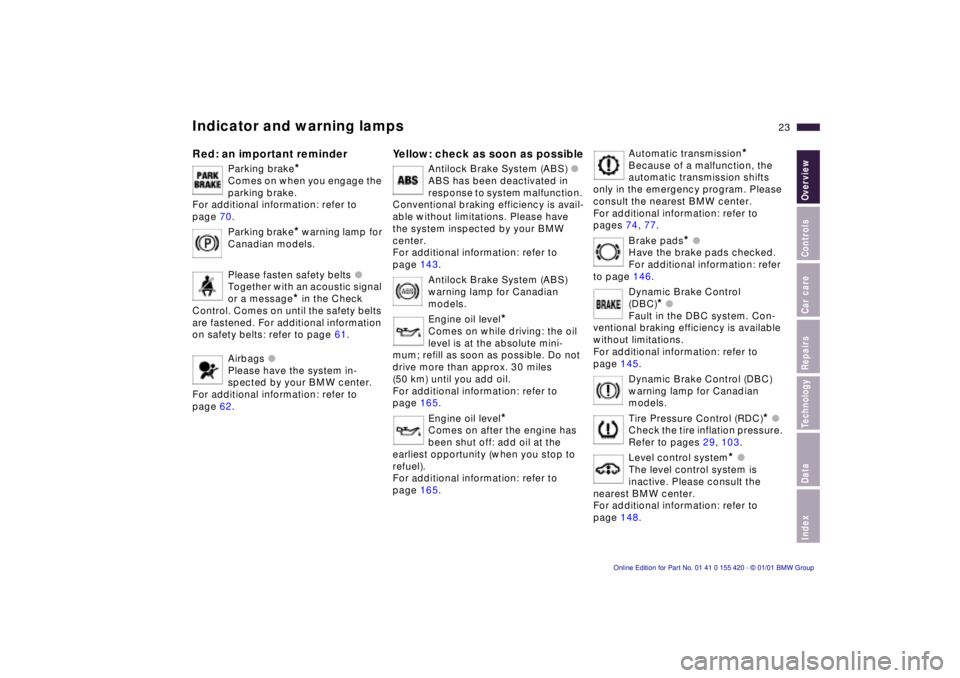
IndexDataTechnologyRepairsCar careControlsOverview
23n
Indicator and warning lampsRed: an important reminder
Parking brake
*
Comes on when you engage the
parking brake.
For additional information: refer to
page 70.
Parking brake
* warning lamp
for
Canadian models.
Please fasten safety belts l
Together with an acoustic signal
or a message
* in the Check
Control. Comes on until the safety belts
are fastened. For additional information
on safety belts: refer to page 61.
Airbags l
Please have the system in-
spected by your BMW center.
For additional information: refer to
page 62.
Yellow: check as soon as possible
Antilock Brake System (ABS) l
ABS has been deactivated in
response to system malfunction.
Conventional braking efficiency is avail-
able without limitations. Please have
the system inspected by your BMW
center.
For additional information: refer to
page 143.
Antilock Brake System (ABS)
warning lamp for Canadian
models.
Engine oil level
*
Comes on while driving: the oil
level is at the absolute mini-
mum; refill as soon as possible. Do not
drive more than approx. 30 miles
(50 km) until you add oil.
For additional information: refer to
page 165.
Engine oil level
*
Comes on after the engine has
been shut off: add oil at the
earliest opportunity (when you stop to
refuel).
For additional information: refer to
page 165.
Automatic transmission
*
Because of a malfunction, the
automatic transmission shifts
only in the emergency program. Please
consult the nearest BMW center.
For additional information: refer to
pages 74, 77.
Brake pads
* l
Have the brake pads checked.
For additional information: refer
to page 146.
Dynamic Brake Control
(DBC)
* l
Fault in the DBC system. Con-
ventional braking efficiency is available
without limitations.
For additional information: refer to
page 145.
Dynamic Brake Control (DBC)
warning lamp for Canadian
models.
Tire Pressure Control (RDC)
* l
Check the tire inflation pressure.
Refer to pages 29, 103.
Level control system
* l
The level control system is
inactive. Please consult the
nearest BMW center.
For additional information: refer to
page 148.
Page 34 of 238
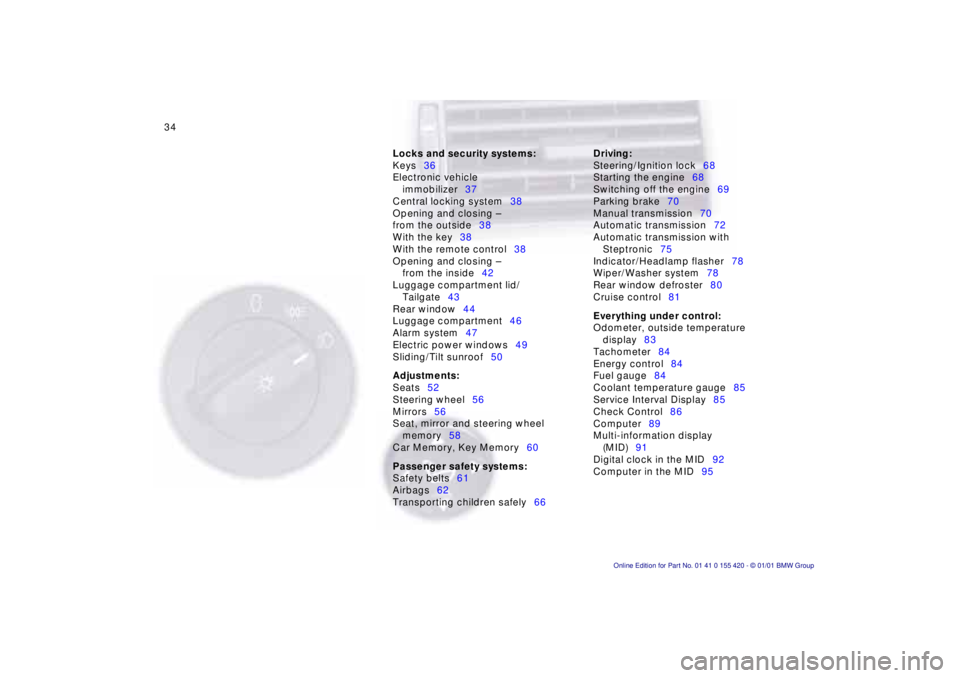
34n
Locks and security systems:
Keys 36
Electronic vehicle immobilizer 37
Central locking system 38
Opening and closing –
from the outside 38
With the key 38
With the remote control 38
Opening and closing – from the inside 42
Luggage compartment lid/ Tailgate 43
Rear window 44
Luggage compartment 46
Alarm system 47
Electric power windows 49
Sliding/Tilt sunroof 50
Adjustments:
Seats 52
Steering wheel 56
Mirrors 56
Seat, mirror and steering wheel memory 58
Car Memory, Key Memory 60
Passenger safety systems:
Safety belts 61
Airbags 62
Transporting children safely 66Driving:
Steering/Ignition lock
68
Starting the engine 68
Switching off the engine 69
Parking brake 70
Manual transmission 70
Automatic transmission 72
Automatic transmission with Steptronic 75
Indicator/Headlamp flasher 78
Wiper/Washer system 78
Rear window defroster 80
Cruise control 81
Everything under control:
Odometer, outside temperature display 83
Tachometer 84
Energy control 84
Fuel gauge 84
Coolant temperature gauge 85
Service Interval Display 85
Check Control 86
Computer 89
Multi-information display (MID) 91
Digital clock in the MID 92
Computer in the MID 95
Page 68 of 238
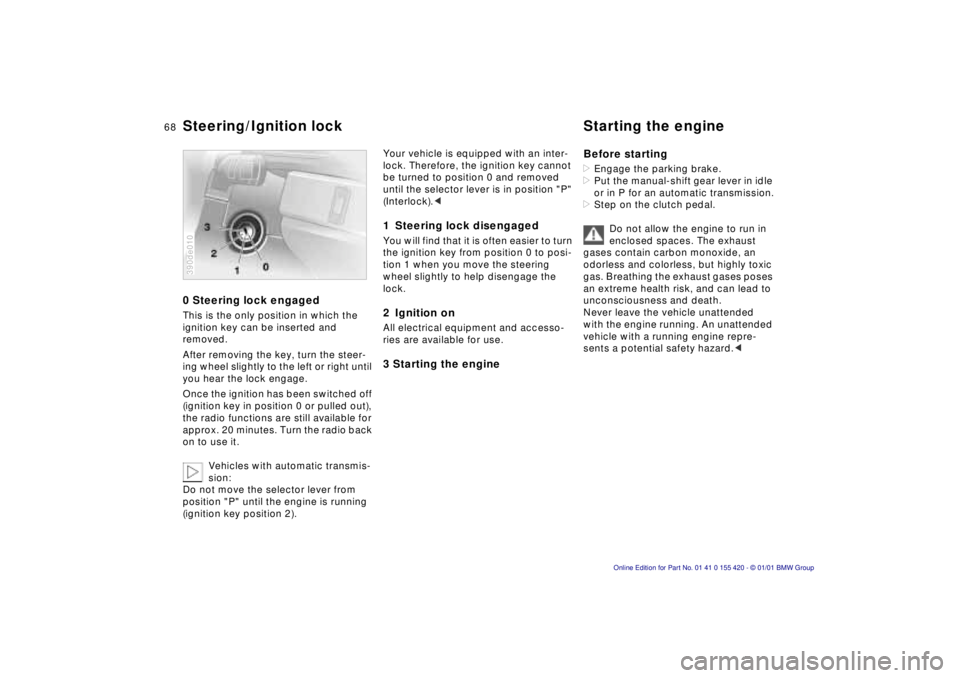
68n
0 Steering lock engagedThis is the only position in which the
ignition key can be inserted and
removed.
After removing the key, turn the steer-
ing wheel slightly to the left or right until
you hear the lock engage.
Once the ignition has been switched off
(ignition key in position 0 or pulled out),
the radio functions are still available for
approx. 20 minutes. Turn the radio back
on to use it.
Vehicles with automatic transmis-
sion:
Do not move the selector lever from
position "P" until the engine is running
(ignition key position 2).390de010
Your vehicle is equipped with an inter-
lock. Therefore, the ignition key cannot
be turned to position 0 and removed
until the selector lever is in position "P"
(Interlock).< 1 Steering lock disengagedYou will find that it is often easier to turn
the ignition key from position 0 to posi-
tion 1 when you move the steering
wheel slightly to help disengage the
lock.2 Ignition onAll electrical equipment and accesso-
ries are available for use.3 Starting the engineBefore starting
>Engage the parking brake.
>Put the manual-shift gear lever in idle
or in P for an automatic transmission.
>Step on the clutch pedal.
Do not allow the engine to run in
enclosed spaces. The exhaust
gases contain carbon monoxide, an
odorless and colorless, but highly toxic
gas. Breathing the exhaust gases poses
an extreme health risk, and can lead to
unconsciousness and death.
Never leave the vehicle unattended
with the engine running. An unattended
vehicle with a running engine repre-
sents a potential safety hazard.<
Steering/Ignition lock Starting the engine
Page 69 of 238

IndexDataTechnologyRepairsCar careControlsOverview
69n
Starting the engine Switching off the engineStarting the engine>Start the engine. Do not press the
accelerator pedal.
Do not actuate the starter for too
short a time. Do not turn it for
more than approx. 20 seconds. Release
the ignition key immediately as soon as
the engine starts.
Do not allow the engine to warm up by
leaving it running while the vehicle re-
mains stationary. Instead, begin driving
immediately at a moderate engine
speed.
BMW 540i with automatic transmission:
Your BMW is equipped with the conve-
nience starting feature. Simply turn the
key to position 3 (starter) and then re-
lease it immediately.
The starter continues to operate auto-
matically.
The automatic starting mode will not
operate if the battery voltage is low.
Should this condition arise, it remains
possible to jump-start the engine (refer
to page 200).<
Should the engine fail to start on the
first attempt (if it is very hot or cold, for
instance):
>Press the accelerator pedal halfway
down while engaging the starter.
Cold starts at extremely low tempera-
tures, from approx. +57 (–156)
and at elevations above 3,300 ft
(1,000 meters):
>Be sure to let the starter remain
engaged somewhat longer the first
time (approx. 10 seconds).
>Press the accelerator pedal halfway
down while engaging the starter.
Engine idle speed is controlled by the
engine computer system. Increased
speeds at start-up are normal and
should decrease as the engine warms
up. If engine speed does not decrease,
service is required.
To prevent the battery from discharg-
ing, always deactivate electrical de-
vices which are not in use. Switch the
ignition off when the vehicle is not
being driven.Turn the ignition key to position 1 or 0.
Never remove the ignition key
while the vehicle is rolling. The
steering locks, making it impossible to
steer the vehicle.
Always remove the ignition key and en-
gage the steering lock before leaving
the vehicle.
Vehicles with manual transmission:
Always engage the parking brake
when parking on slopes and inclined
surfaces, since not even placing the
lever in 1st gear or reverse may not
provide adequate resistance to rolling.
Vehicles with automatic transmission:
Place the selector lever in "Park."<
Vehicles with automatic transmission
*:
The vehicle must be stationary and the
selector lever in "Park" before you can
remove the ignition key.
Page 70 of 238
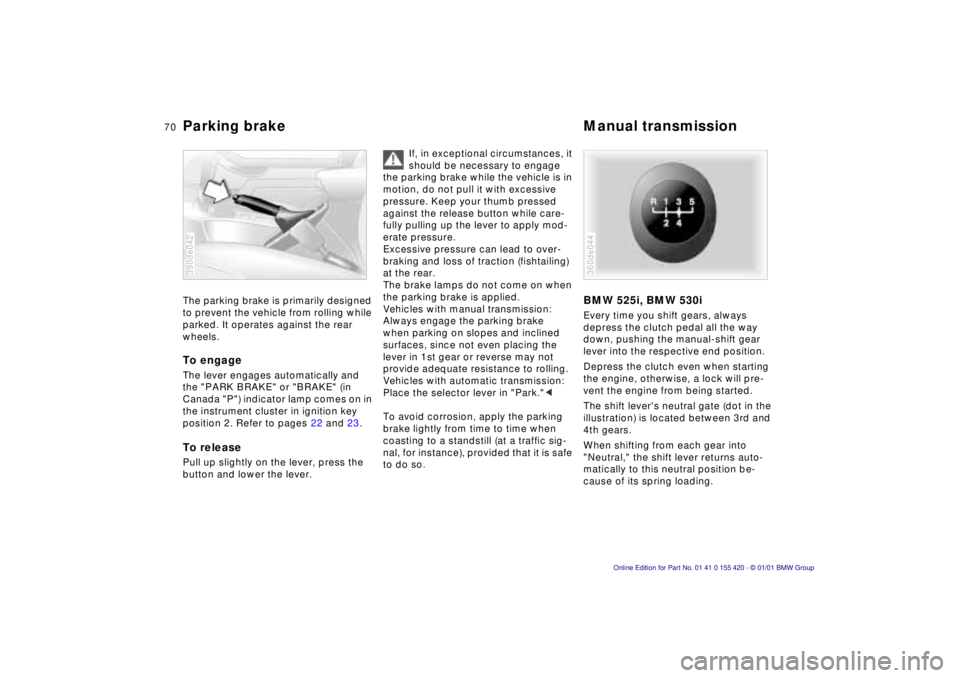
70n
Parking brake Manual transmissionThe parking brake is primarily designed
to prevent the vehicle from rolling while
parked. It operates against the rear
wheels.To engageThe lever engages automatically and
the "PARK BRAKE" or "BRAKE" (in
Canada "P") indicator lamp comes on in
the instrument cluster in ignition key
position 2. Refer to pages 22 and 23.To releasePull up slightly on the lever, press the
button and lower the lever.390de042
If, in exceptional circumstances, it
should be necessary to engage
the parking brake while the vehicle is in
motion, do not pull it with excessive
pressure. Keep your thumb pressed
against the release button while care-
fully pulling up the lever to apply mod-
erate pressure.
Excessive pressure can lead to over-
braking and loss of traction (fishtailing)
at the rear.
The brake lamps do not come on when
the parking brake is applied.
Vehicles with manual transmission:
Always engage the parking brake
when parking on slopes and inclined
surfaces, since not even placing the
lever in 1st gear or reverse may not
provide adequate resistance to rolling.
Vehicles with automatic transmission:
Place the selector lever in "Park."<
To avoid corrosion, apply the parking
brake lightly from time to time when
coasting to a standstill (at a traffic sig-
nal, for instance), provided that it is safe
to do so.
BMW 525i, BMW 530iEvery time you shift gears, always
depress the clutch pedal all the way
down, pushing the manual-shift gear
lever into the respective end position.
Depress the clutch even when starting
the engine, otherwise, a lock will pre-
vent the engine from being started.
The shift lever's neutral gate (dot in the
illustration) is located between 3rd and
4th gears.
When shifting from each gear into
"Neutral," the shift lever returns auto-
matically to this neutral position be-
cause of its spring loading.360de044
Page 71 of 238
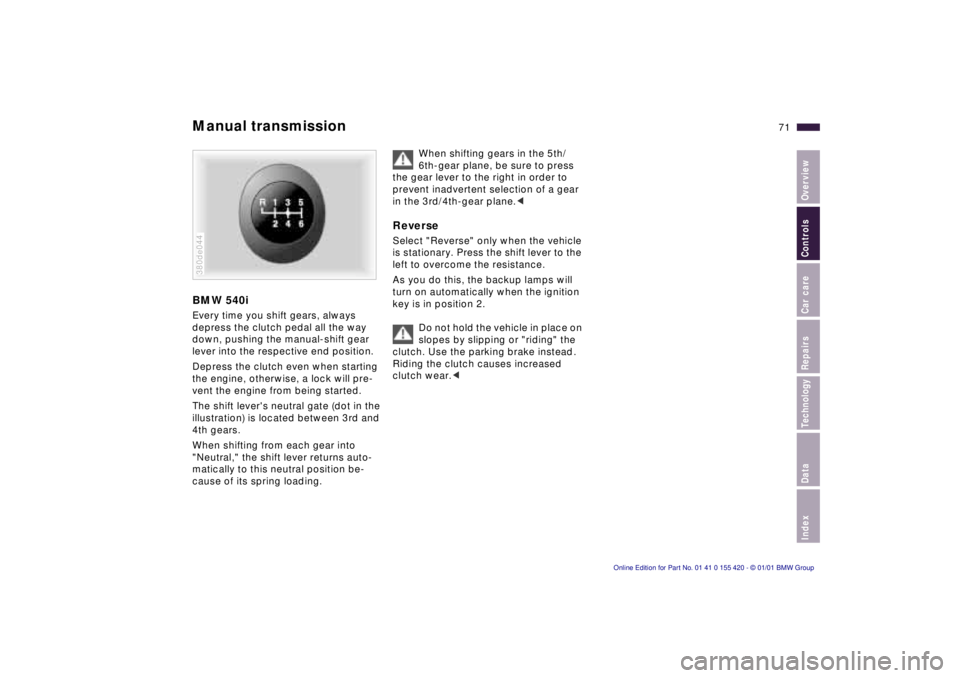
IndexDataTechnologyRepairsCar careControlsOverview
71n
Manual transmissionBMW 540iEvery time you shift gears, always
depress the clutch pedal all the way
down, pushing the manual-shift gear
lever into the respective end position.
Depress the clutch even when starting
the engine, otherwise, a lock will pre-
vent the engine from being started.
The shift lever's neutral gate (dot in the
illustration) is located between 3rd and
4th gears.
When shifting from each gear into
"Neutral," the shift lever returns auto-
matically to this neutral position be-
cause of its spring loading.380de044
When shifting gears in the 5th/
6th-gear plane, be sure to press
the gear lever to the right in order to
prevent inadvertent selection of a gear
in the 3rd/4th-gear plane.<
ReverseSelect "Reverse" only when the vehicle
is stationary. Press the shift lever to the
left to overcome the resistance.
As you do this, the backup lamps will
turn on automatically when the ignition
key is in position 2.
Do not hold the vehicle in place on
slopes by slipping or "riding" the
clutch. Use the parking brake instead.
Riding the clutch causes increased
clutch wear.<